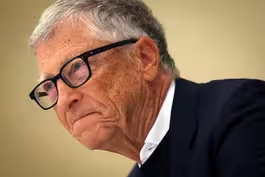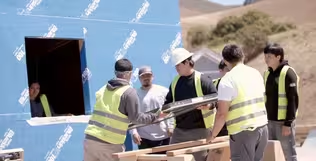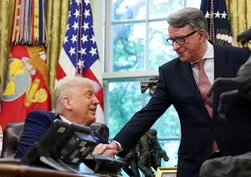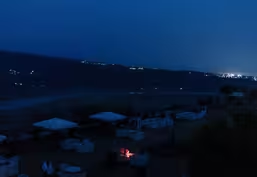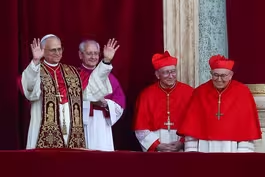
What it will take to update U.S. air traffic control system
Clip: 5/8/2025 | 5m 22sVideo has Closed Captions
What it will take to update the aging U.S. air traffic control system
Transportation Secretary Sean Duffy unveiled an ambitious new plan to modernize the air traffic control system aimed at improving safety and reducing delays. The overhaul would cost tens of billions of dollars and replace outdated equipment that is showing its age. But the plan faces other hurdles. Geoff Bennett discussed more with aviation correspondent Miles O’Brien.
Problems playing video? | Closed Captioning Feedback
Problems playing video? | Closed Captioning Feedback
Major corporate funding for the PBS News Hour is provided by BDO, BNSF, Consumer Cellular, American Cruise Lines, and Raymond James. Funding for the PBS NewsHour Weekend is provided by...

What it will take to update U.S. air traffic control system
Clip: 5/8/2025 | 5m 22sVideo has Closed Captions
Transportation Secretary Sean Duffy unveiled an ambitious new plan to modernize the air traffic control system aimed at improving safety and reducing delays. The overhaul would cost tens of billions of dollars and replace outdated equipment that is showing its age. But the plan faces other hurdles. Geoff Bennett discussed more with aviation correspondent Miles O’Brien.
Problems playing video? | Closed Captioning Feedback
How to Watch PBS News Hour
PBS News Hour is available to stream on pbs.org and the free PBS App, available on iPhone, Apple TV, Android TV, Android smartphones, Amazon Fire TV, Amazon Fire Tablet, Roku, Samsung Smart TV, and Vizio.
Providing Support for PBS.org
Learn Moreabout PBS online sponsorshipGEOFF BENNETT: Transportation Secretary Sean Duffy unveiled a new plan to modernize the air traffic control system aimed at improving safety and reducing delays by the year 2028.
The overhaul would cost tens of billions of dollars and replace more than 600 outdated systems, including old wiring, the kind of wiring that affected computers at Newark Airport, which has led to hundreds of cancellations and triggered new questions about the safety of the air traffic control system.
SEAN DUFFY, U.S. Transportation Secretary: So what we use today is copper wires.
We're one of the last institutions, last businesses that actually use copper wires.
We shop on eBay to replace parts to fix our equipment in the system that keeps you safe.
GEOFF BENNETT: But the plan faces big hurdles.
We're joined now by our aviation correspondent, Miles O'Brien.
Miles, it's great to have you here.
So, first, is what he said true that you have air traffic controllers going to eBay to find parts to fix the system?
MILES O'BRIEN: I hadn't heard that detail, Geoff, but it doesn't surprise me a bit.
We're talking about technology that really looks like it belongs on the set for "Apollo 13" or a computer museum, literally floppy disks, which people of a certain generation wouldn't even know what those were.
Copper wire, of course, is what carried landline phone lines into our homes for many years.
All of this is outmoded by satellite and fiber technology.
And, clearly, that communication Achilles' heel needs to be addressed quickly, as we have seen at Newark.
GEOFF BENNETT: So what technologies is Duffy talking about as a solution, at least by the year 2028, he's saying?
MILES O'BRIEN: Well, some of the things you have to think about are replacing the radar systems.
These old radars, some of them are 50-, 60-year-old technology or 50- or 60-year-old radars, for that matter.
They have a built-in latency in them, some of them as long as 12 seconds, before the whole radar to spin around.
That's what we're talking about here.
And that latency is what requires aircraft to be separated further than they would be if it was replaced by a satellite-based system, GPS-type system.
The FAA has been slow to move in this direction.
And that's one thing.
It would be a lot better if air traffic controllers weren't keeping track of aircraft with paper strips, which they use to stack up, to keep track of flights that are coming their way.
There's an awful lot of verbal communication.
They use binoculars to make sure that aircraft are in the right place at an airport.
And there are automatic sensors that can be installed that can warn them of a potential collision.
All these things are what you need for a modern air traffic control system with the capacity that this system requires right now.
GEOFF BENNETT: And, Miles, wasn't there funding that was passed by Congress and signed into law for -- by President Biden for this very thing?
MILES O'BRIEN: Yes, the bipartisan infrastructure legislation did in fact have $25 billion over five years for the FAA.
But if you read the fine print on that one, the money was not allocated for air traffic control.
It was allocated for things like airport improvement.
And so the air traffic control system is in dire need of a fix.
And to see the industry come together, as it did today, in a unified way like I have never seen before proves that that midair collision at Reagan National Airport in January has been a real galvanizing event.
The trick here, Geoff, is, you really need to spend the money more or less all at once in order to fix the system efficiently.
If it takes too long, it costs more, and you have to keep those floppy disks and copper wires and paper strips going simultaneously with a new system.
GEOFF BENNETT: That's a great point.
So what's the interim solution, if there is one?
MILES O'BRIEN: Well, improving the communication system would be a good, easy interim way to get started here.
What we saw at Newark is completely avoidable by just upgrading to fiber and satellite.
That's a good start.
I think it's important for the industry to come together with the FAA and recognize that the system is beyond capacity.
Those delays that you saw at Newark, if you really think about it, are a way of indicating that the system is responding safely.
The FAA reduced the amount of traffic into the system because it didn't feel it had layers of safety.
So the airlines need to be on board with this as well.
And the FAA should probably be limiting the operations at some of these airports until those cables can be wired in and those radars can be more reliable to ensure safety.
GEOFF BENNETT: That is Miles O'Brien.
Miles, our thanks to you, as always.
We appreciate it.
MILES O'BRIEN: You're welcome, Geoff.
Bill Gates on why he's donating his remaining wealth
Video has Closed Captions
Clip: 5/8/2025 | 11m 5s | Bill Gates on why he's donating his remaining wealth and his concerns about U.S. aid cuts (11m 5s)
A Brief But Spectacular take on building a brighter future
Video has Closed Captions
Clip: 5/8/2025 | 3m 41s | A Brief But Spectacular take on building a brighter future (3m 41s)
The impact Trump's tariffs are having on supply chains
Video has Closed Captions
Clip: 5/8/2025 | 11m 11s | The impact Trump's tariffs are already having on global supply chains and U.S. businesses (11m 11s)
Pope Leo XIV becomes first American to lead Catholic Church
Video has Closed Captions
Clip: 5/8/2025 | 2m 38s | Pope Leo XIV selected as first American to lead Catholic Church (2m 38s)
U.S. pushes for de-escalation as India, Pakistan trade fire
Video has Closed Captions
Clip: 5/8/2025 | 2m 58s | U.S. pushes for de-escalation as India and Pakistan trade fire and accusations (2m 58s)
What Pope Leo's election means for the future of the church
Video has Closed Captions
Clip: 5/8/2025 | 7m 53s | What Pope Leo XIV's election means for the future of the church and Catholics worldwide (7m 53s)
Providing Support for PBS.org
Learn Moreabout PBS online sponsorship
- News and Public Affairs

FRONTLINE is investigative journalism that questions, explains and changes our world.

- News and Public Affairs

Today's top journalists discuss Washington's current political events and public affairs.












Support for PBS provided by:
Major corporate funding for the PBS News Hour is provided by BDO, BNSF, Consumer Cellular, American Cruise Lines, and Raymond James. Funding for the PBS NewsHour Weekend is provided by...
